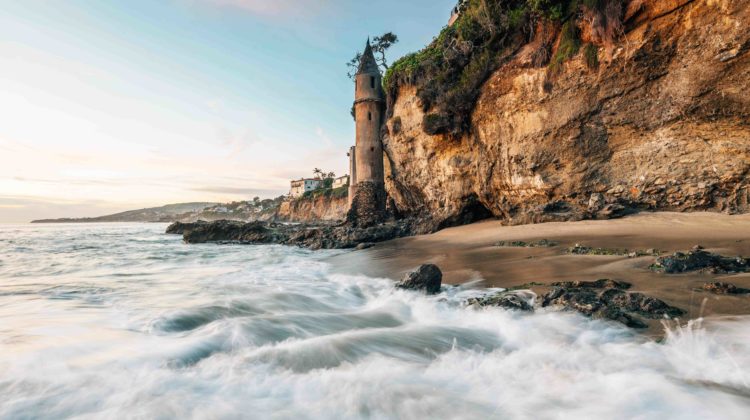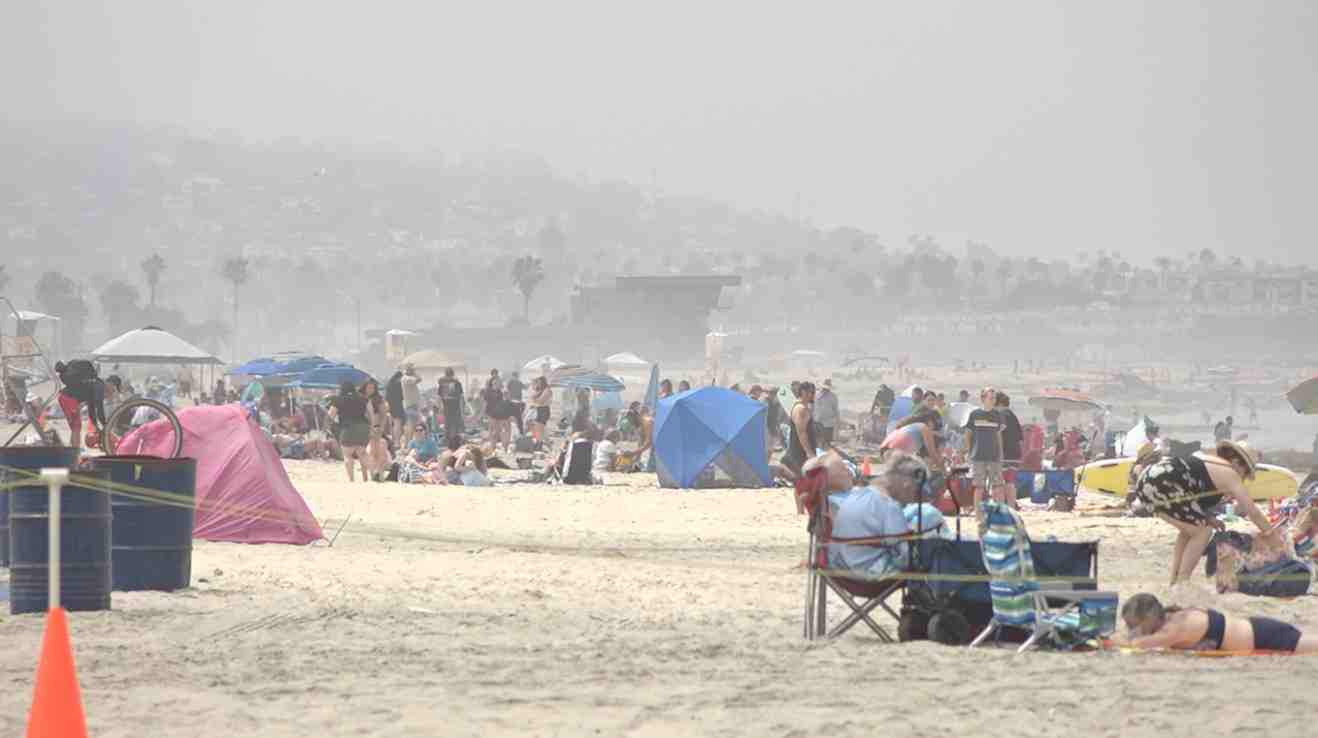
San Diego County beaches could see some of the worst crowds they’ve seen in years this weekend as people flock to the coast to escape an oppressive heat wave that will push temperatures in the valleys and foothills inland into the 100- to 110-degree range in much of the area. .
The National Weather Service says people will also be looking for help as dew points will reach 70 degrees or higher, making the air feel tropical. And nighttime temperatures will be unusually high, from 70 to 79 degrees across the county.
Even the surf will be warm; it is expected to be 70 to 75 degrees in many areas.
The heat wave started on Tuesday and will peak on Saturday and Sunday. But Monday – Labor Day – will be only slightly cooler.
High temperatures led to another Flex Alert called by the operator that manages 80 percent of California’s electric grid.
Concerned that spikes in energy demand — primarily from homeowners and businesses cranking up their air conditioning units — could push the power system to the brink, California’s Independent System Operator on Friday extended its call to consumers to voluntarily reduce energy use between 4 a.m. and 9 p.m. until Saturday.
During the Flex Alert, ISO recommends that utility customers:
SDG&E does not plan to implement temporary power outages in San Diego County due to the increased risk of wildfires.
The utility says on its weather page that there are no so-called power outages for public safety until Sept. 8. This is largely based on the fact that the county will not be hit by strong Santa Ana winds this weekend.
The wind will be relatively weak, and the relative humidity will be from 20 to 30 percent. Santa Ana often drops humidity levels below 10 percent.
The weather service did inject a degree of concern into the matter, saying Friday that monsoonal moisture could produce electrical storms east and west of the mountains. Lightning is the primary cause of forest fires.
The US Forest Service closed the popular Three Sisters Falls and Eagle Peak hiking areas until Monday, citing “health and safety concerns related to extreme heat and fire risk.”
High temperatures are expected for Saturday
San Diego International Airport: 87 or 10 degrees above averageVista: 96 or 13 degrees above averageChula Vista: 89 or 10 degrees above averageEscondido: 101 or 12 degrees above averageEl Cajon: 102 or 12 degrees above averageRamona: 102 or 12 degrees above averageAlpes : 99 or 12 degrees above average Palomar Mountains: 90 or 9 degrees above average Lake Cuyamaca: 92 or 9 degrees above average Campo: 99 or 6 degrees above average Borrego: 111 or 8 degrees above average
Source: National Meteorological Service
13:34 2 September 2022: This story has been updated with new temperature, dew point and surf information. 9:41 a.m., September 2, 2022: Story updated with closures in Cleveland National Forest due to weather.
13:34 2 September 2022: This story has been updated with new temperature, dew point and surf information.
9:41 a.m., September 2, 2022: Story updated with closures in Cleveland National Forest due to weather.
Does San Diego have perfect weather?

| Nice order | 21 |
|---|---|
| City name | San Antonio |
| Climate | 74 |
| Population | 8 |
| The highest apartment prices | 21 |
What’s the weather like in San Diego? Climate and average weather throughout the year in San Diego, California, United States. In San Diego, summers are short, hot, dry, and clear, and winters are long, cold, and partly cloudy. During the year the temperature usually varies from 50°F to 77°F and is rarely below 44°F or above 84°F.
Does LA or San Diego have better weather?
Los Angeles has an average of 284 sunny days a year. The American average is 205 sunny days. San Diego, California receives an average of 11.7 inches of rain per year. Los Angeles, California receives an average of 15.5 inches of rain per year.
Should I go to San Diego or Los Angeles?
Overall, I would recommend San Diego if you are looking for a family vacation if you have lots of different things to do. Alternatively, I would choose Los Angeles if you want to explore iconic places, learn about Hollywood and immerse yourself in a diverse culinary scene.
Is it warmer in Los Angeles or San Diego?
I’ve noticed that San Diego tends to have cooler weather than Los Angeles, even though it’s south of Los Angeles. I wonder why. San Diego has a maritime climate, heavily influenced by the cool temperatures of the Pacific Ocean that range from the 50s to the 60s annually.
Does San Diego have the best climate in the world?
San Diego. This coastal Southern California location arguably has the best weather of any major city in the United States. With an average coldest month temperature of 65 degrees F and a warmest month high of 76, you can’t go wrong with sunny San Diego and its beautiful beaches.
Does California have the best weather in the world?
Based on these criteria, California has the best weather of all 50 states. Coastal cities in southern and central California, such as San Diego, Los Angeles, Long Beach, and Santa Barbara, experience only 20 inches of rain per year and temperatures typically between the low 60s and 85 degrees.
Why is San Diego weather so perfect?
San Diego has a maritime climate, heavily influenced by the cool temperatures of the Pacific Ocean that range from the 50s to the 60s annually. As the cold ocean air spreads inland, it gradually warms, with much higher temperatures in the inland valleys.
What is the warmest time of year in San Diego?

Late summer and early fall are usually the warmest times of the year with average temperatures of 78 degrees in August and 77 degrees in September. Snow and ice are rare in winter and usually only occur in mountainous areas with higher elevations and much deeper than the coast.
How hot is San Diego in the summer? Almost every day in July heats up to over 70 degrees Fahrenheit (21 degrees Celsius) in San Diego. This month, the city averages 4 days when the thermometer reaches 80 °F (over 26 °C). Temperatures above 90 °F (32 °C) occur in July about once a decade. July is usually not as cold as 60 °F (16 °C).
What is the best month to go to San Diego?
The best month to visit is September, after the crowds die down for Labor Day and the kids are back in school. Hotel prices tend to drop, San Diego beaches are less crowded, and the weather is still fantastic.
What is the best weather month in San Diego?
Late summer, especially September, usually boasts the best weather, warmest ocean temperatures, and less crowds. Most people come to San Diego for its beautiful beaches, and if enjoying the water, sand and sun is your priority, plan your visit for the summer. But be warned…
What is the rainy season in San Diego?
The rainy season of the year lasts for 5.9 months, from October 25 to April 22, with a rolling 31-day rainfall of at least 0.5 inches. The rainiest month in San Diego is February, with an average of 2.3 inches of precipitation. The period without rain in the year lasts 6.1 months, from April 22 to October 25.
What time of year is the best weather in San Diego?
Weather in San Diego. Spring is one of the best times to visit America’s most beautiful city. The weather is mild (temperatures average in the mid to upper 60s) and there are fewer visitors to share the streets and roads with compared to summer.
What is the best month for weather in San Diego?
Late summer, especially September, usually boasts the best weather, warmest ocean temperatures, and less crowds. Most people come to San Diego for its beautiful beaches, and if enjoying the water, sand and sun is your priority, plan your visit for the summer.
What is the rainy season in San Diego?
The most rain falls between November and March. Snow and ice are rare in winter. The record low temperature was minus 4 degrees Celsius (25° Fahrenheit). San Diego averages about 145 sunny days and 115 cloudy days per year.
Does it get hot in San Diego in the summer?

How hot is San Diego in July? Although it can be hot in San Diego, the average temperature is moderate. It’s warm all year round, but it doesn’t get that hot compared to the desert. It is rarely cold, but in summer it remains at a moderate and warm temperature.
Does San Diego have hot weather? Weather and climate in San Diego The city is known for its excellent weather, which is generally warm and mild throughout the year, especially on the coast.
Is San Diego cold in the summer?
The June gloom tends to disappear, and July weather in San Diego mostly equates to sunny days. It’s a fantastic time to visit. The temperature ranges from a low of 66° to a high of 76°. Approximately 0 days of rain and 293 hours of sunlight.
Is it cold in San Diego in July?
July. The June gloom tends to disappear, and July weather in San Diego mostly equates to sunny days. It’s a fantastic time to visit. The temperature ranges from a low of 66° to a high of 76°.
Is San Diego cold or hot?
With mild average temperatures each season and hot, warm and dry summers, San Diego is a popular tourist destination for visitors from around the world, as well as a relocation destination for people looking to relocate.
Why does it not get hot in San Diego?
San Diego has a maritime climate, heavily influenced by the cool temperatures of the Pacific Ocean that range from the 50s to the 60s annually. As the cold ocean air spreads inland, it gradually warms, with much higher temperatures in the inland valleys.
Why has it been so cold in San Diego?
Forecasters attribute the large cooling to an updraft. Strong onshore winds, mostly northwesterly, have been hitting the coast for several days. These winds push the warmer, upper layers of the ocean away from the coast, allowing cooler, deeper water to rise to the surface.
Does it ever get hot in San Diego?
On average, 344 days of the year are warmer than 60 °F (16 °C), but only 25 days are warmer than 80 °F (27 °C). Late summer and early fall are typically the warmest times of the year with average highs of 78 °F (26 °C) in August and 77 °F (25 °C) in September. Temperatures occasionally reach 90 °F (32 °C) or higher.
